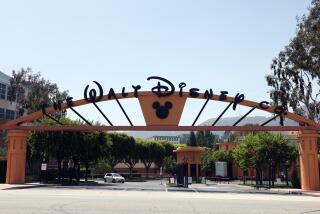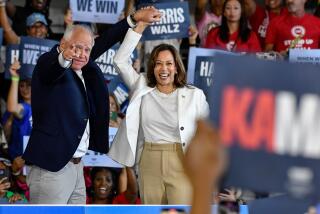Sears Sex-Bias Suit Could Have Major Impact
- Share via
Sears, Roebuck & Co., the nation’s largest retailer, faces the prospect of paying tens of millions of dollars to women in a class-action suit if it has failed to convince the U.S. District Court in Chicago that men are usually more assertive than women and that men are better at selling “male type” products such as auto accessories, televisions and fences while women do best with such items as women’s clothing and draperies.
This particular case actually began in 1973, when the Equal Employment Opportunity Commission first charged that Sears had stereotyped men and women. The result has been that the best-paying jobs at the company usually go to men. Over the years, arguments toward some type of settlement continued, but the case didn’t come to trial until this year.
U.S. District Judge John A. Nordberg’s ruling is expected soon. And because the 10-month trial has been so emotionally charged, there is widespread agreement that its outcome could have a widespread impact on the future of employment for women in many key jobs.
Top Reagan Administration officials have made no secret of the fact that they would be happy to see Sears win the case brought against it by the government’s EEOC because the Administration opposes massive class-action suits to stop alleged corporate discrimination against women or minorities.
Instead, Administration officials argue, the government should only help individuals who can prove that they have personal, clear-cut cases of discrimination and forget about trying to prosecute companies because of alleged overall discriminatory policies.
Whatever the outcome of the Sears case, it is almost certain to be the last large class-action discrimination case as long as the Reagan Administration or a similar-minded one is in the White House.
Nevertheless, EEOC attorneys have ignored what less-dedicated government employees might have taken as a mandate from the White House to “lay off” Sears.
“If we win, present anti-discrimination laws can continue to be at least partially effective,” said an EEOC official who asked not to be identified. “If we lose, employers around the country will take a Sears victory as a signal that they can get away with stereotyping women as passive, fearful people who are just not capable of holding high-pressure jobs that require long hours of work and selling products usually associated more with men than women.”
Sears has said that it has more men than women in well-paying, “big-ticket” commission sales jobs because of differences in the personalities and interests of the average male and female.
Karen H. Baker, an EEOC attorney who helped prosecute the case, said during the trial that, while Sears stressed women’s “family responsibilities” to explain the small number of women in those big-ticket, well-paid jobs, women want them precisely because many of them have children and need the larger paychecks that commission sales jobs offer.
Sears’ attorney, Charles Morgan Jr., former head of the Washington office of the American Civil Liberties Union, said Sears’ witnesses argued that women often declined promotion to high-pressure commission jobs because “aggressiveness and assertiveness” are more prevalent in men and that men are less reluctant not only to work long hours but also to go to the homes of customers at night, if necessary.
As a result, he said, women dominate commission selling of draperies and rugs, while men make up the majority in sales of automotive products such as oil, truck tires and home-improvement products.
Such remarks infuriate many EEOC attorneys and feminists who point out that women selling draperies and rugs, for instance, have to work long hours and go to homes of customers at night more often than men selling automotive products and home-improvement products such as fences.
Morgan countered that the saleswomen can talk to customers in their living rooms at night, but that the men selling automotive products must often go into the garages or cellars, which men do more readily. From those on the other side, that argument brought mostly laughter.
Sears conceded that, as Jon Wiener, history professor at the University of California, Irvine, noted, applicants for the big-ticket commission jobs were given tests that asked whether they like boxing, swear often or enjoy an event more when betting is involved.
Morgan insisted that women’s answers to such questions were “discounted when test results were tabulated.” But the EEOC insisted that the questions reflected a Sears view that it prefers to hire those with a highly masculine style and, since that usually means men, the result is discriminatory.
Even if the courts decide that, as Sears insists, it does not stereotype women, the practice is still not uncommon. In time, however, such stereotyping should go out of style, as it already has in real estate, where sales jobs were once regarded primarily as the domain of men. Today, about 40% of those jobs are held by women, and the majority of new entrants are female.
Chrysler’s Concessions
The contract settlement for higher wages reached last week between the United Auto Workers and Chrysler may have accomplished two additional goals: It at least partially repaid Chrysler workers for the $1-billion “investment” that they made by accepting wage and fringe benefit cuts to keep the company alive in 1979, and it could encourage other unions to renew the concept of “pattern bargaining” to keep wages and benefits from being competitive factors among corporations.
Chrysler had little choice last week other than to accept most of the UAW’s contract proposals after a 12-day strike: A more prolonged walkout would have damaged, if not wrecked, the company just as it seemed almost fully recovered from its nearly bankrupt state in 1979. Then, with critical lobbying from then-UAW President Douglas Fraser and other union leaders, it was saved by a federal government loan guarantee and the concessions from its workers, who agreed to forgo wage hikes and fringe benefits.
When Chrysler substantially cut its workers’ wages and benefits, it had a labor cost advantage over its major competitors in the United States. Companies in other industries such as steel, airlines and copper began trying the same thing: seeking a competitive edge by not paying their workers as much as other firms in their industries.
It is too soon to say with certainty, but now that pattern bargaining seems to have been restored in the auto industry, where it suffered its first major blow, other businesses may again follow the auto industry’s lead and return to the concept that prevents companies from cutting wages and benefits of workers as a device for competing with rival firms.
The settlement at Chrysler didn’t come easily--it took 42 hours of marathon negotiations. But one reason the agreement did come after only a 12-day strike was that both the company and union had, as one union officer put it, “worked together in the trenches so hard to keep the company afloat” during its near-bankruptcy days that they had a mutual respect for one another’s position even though they had disagreements over how best to resolve some of the crucial contract issues.
Chrysler workers will get the current industry average of $13.29 an hour and bonuses totaling about $184 million. That will not repay them for the $1-billion investment that they made in the company through their 1979 concessions to help save Chrysler--and their jobs. But it was a better return on their investment than most of them had expected.
And Chrysler has also agreed to let the workers get full rights in Chrysler stock that they received when they did make their wage and fringe benefit concessions.
Until now, the employee shareholders had no voting rights, and the stock could be cashed in only when the worker left Chrysler. Now, workers--who own about 15% of all Chrysler shares, averaging about $6,000 per worker--can sell the stock whenever they want to or keep it and hope its value increases. That was a bleak hope back in 1979.
Presser’s Problems
Teamster President Jackie Presser strengthened his ties with Teamsters in Southern California recently by nominating Mike Riley, head of the Southern California Teamsters Joint Council 42, to be a vice president of the international union.
Riley will remain in his job here. He is certain to get the necessary final approval for the additional job from the union’s 18-member general executive board that includes 16 vice presidents, Presser and the international’s secretary-treasurer, Weldon Mathis.
Presser may well help his standing within the Teamsters by his nomination of Riley: The Southern Californian is highly regarded here not only by other Teamster leaders but also by officers of other unions, including those affiliated with the AFL-CIO, which ousted the Teamsters from its ranks in 1957 on charges that the union was dominated by corrupt leaders.
Presser’s problems outside his own union, however, are far from over. The Reagan Administration last July dropped a lengthy labor fraud probe (of alleged payroll padding) into Presser’s activities after it was publicly disclosed that Presser had been secretly serving as an FBI informant.
But the House Judiciary crime subcommittee is seeking documents that include a 100-page memorandum from Justice Department strike force prosecutors recommending an indictment of Presser. So far, the department has refused to give the House subcommittee the material.
A federal grand jury is conducting an investigation of the case, and both the Senate permanent subcommittee on investigations and leaders of the Senate Judiciary Committee are looking into Presser’s activities and the Justice Department’s dropping of the case.
But those problems apparently haven’t slowed Presser’s activities within his union. The Southern California Teamster newspaper reported that, on Oct. 9, Presser spoke to about 600 delegates to a conference of Teamsters Joint Council 42 here, briefing them on his recent trip with other Teamster leaders to several European countries “where meetings were held with government and union leaders to explain the Teamsters’ emerging impact and actions on international organizing and trade.”
Presser predicted that the union would raise $5 million in donations for political activities from its nearly 2 million members. That would be a major increase in funding of the Teamsters’ political action program.
More to Read
Inside the business of entertainment
The Wide Shot brings you news, analysis and insights on everything from streaming wars to production — and what it all means for the future.
You may occasionally receive promotional content from the Los Angeles Times.










